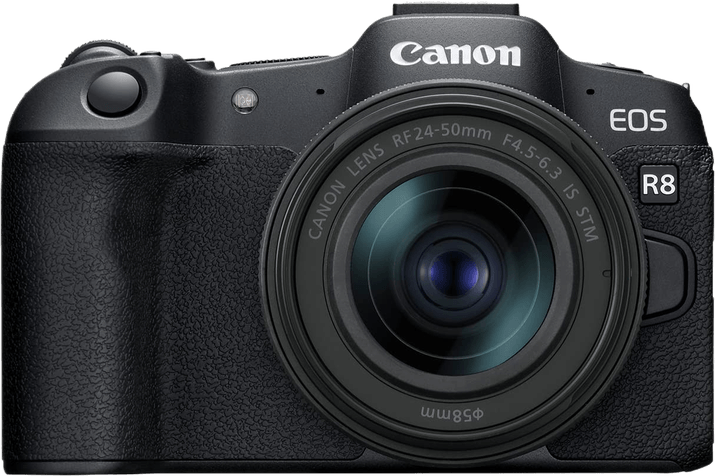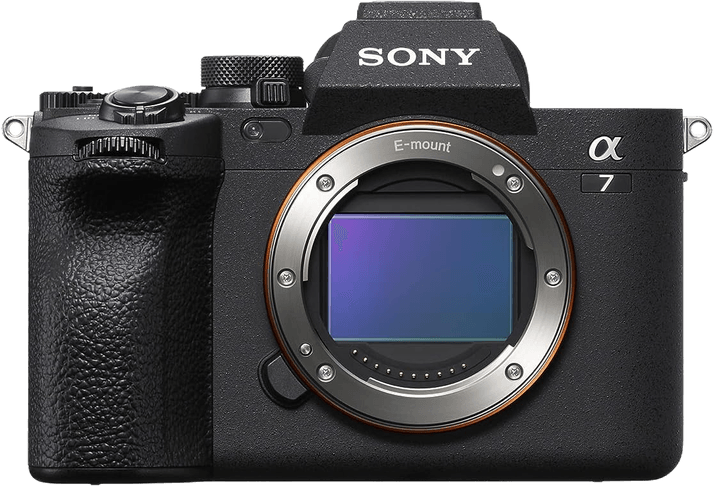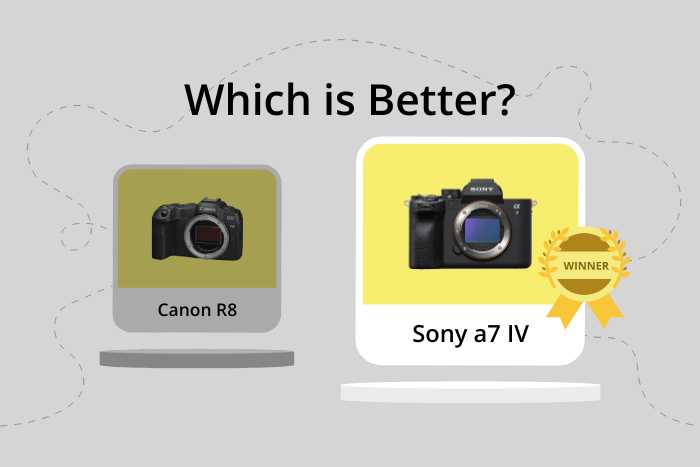Canon EOS R8 vs Sony a7 IV Comparison
Canon EOS R8

Sony a7 IV

The Sony a7 IV outshines the Canon EOS R8 with a score of 84/100 compared to the R8’s 76/100. Both cameras are mirrorless and share similar dimensions, with the Canon EOS R8 measuring 133 x 86 x 70mm and the Sony a7 IV at 131 x 96 x 80mm. They also both have comparable launch prices, with the R8 at $1499 and the a7 IV at $2499.
The Sony a7 IV surpasses the Canon EOS R8 due to its higher score, which signifies its superior features and performance. However, the Canon EOS R8 has its advantages, including its lighter weight of 461g compared to the Sony a7 IV’s 659g. This makes the R8 more convenient for portability and travel.
Taking into account the scores, specifications, and prices, the Sony a7 IV emerges as the stronger contender in this comparison. The Canon EOS R8, though, remains a viable option for those prioritizing a lighter camera without compromising on quality.
Canon EOS R8 vs Sony a7 IV Overview and Optics
The Sony a7 IV outperforms the Canon EOS R8 in optics with a score of 85/100 compared to the R8’s 77/100. Both cameras share several similar specifications, including a CMOS sensor, full-frame sensor size, and compatible lens mounts (Canon RF for the R8 and Sony FE for the a7 IV). However, the Sony a7 IV has some advantages that lead to its higher score.
The Sony a7 IV boasts a higher megapixel count at 33 compared to the Canon EOS R8’s 24. This difference allows the a7 IV to capture more detailed images, making it a better choice for photographers who require high-resolution output. Additionally, the a7 IV’s DXOMARK sensor score is 97, while the R8’s is 94, indicating that the a7 IV’s sensor delivers better overall image quality. The a7 IV also features image stabilization, which the R8 lacks, providing an advantage for photographers who shoot handheld or in low light conditions.
On the other hand, the Canon EOS R8 has a significantly higher shooting speed of 40 frames per second, compared to the Sony a7 IV’s 10 frames per second. This makes the R8 a more suitable option for action and sports photography, where capturing fast-moving subjects is crucial.
Taking these factors into account, the Sony a7 IV emerges as the better camera in terms of optics due to its higher megapixel count, superior sensor performance, and image stabilization. However, the Canon EOS R8 might be more suitable for certain photography niches, such as sports and action, owing to its faster shooting speed. Ultimately, the choice between these two cameras will depend on the specific needs and preferences of the photographer.
Canon EOS R8 vs Sony a7 IV Video Performance
The Canon EOS R8 and the Sony a7 IV have the same video score of 91/100, indicating that both cameras possess strong video capabilities. The shared specifications include a 4K max video resolution with dimensions of 3840 x 2160 and built-in time-lapse functionality.
The Canon EOS R8 has a higher max video frame rate of 180fps compared to the Sony a7 IV’s 120fps. This advantage allows the EOS R8 to capture smoother slow-motion footage, which is beneficial for videographers working with action scenes or sports events. The higher frame rate of the EOS R8 makes it the superior choice for capturing fast-paced movement in high-resolution video.
While the Sony a7 IV has a lower max video frame rate, it still offers solid video capabilities with its 120fps. For many users, this frame rate is sufficient for capturing high-quality video content. The a7 IV is not necessarily worse than the EOS R8, but it does not have the same level of performance in terms of frame rate.
Both the Canon EOS R8 and the Sony a7 IV are strong contenders in the video department, with each camera offering impressive 4K video resolution and built-in time-lapse functionality. The EOS R8 takes the lead with its higher max video frame rate, making it the better option for capturing fast-paced action. However, the Sony a7 IV remains a reliable choice for users who do not require the additional frame rate capabilities. Ultimately, the decision between these two cameras will depend on the specific video needs of the user.
Canon EOS R8 vs Sony a7 IV Features and Benefits
The Canon EOS R8 wins the features comparison with a score of 85/100, while the Sony a7 IV scores slightly lower at 83/100. Both cameras share several specifications, including a 3-inch screen size, touchscreen capabilities, flip screens, and the absence of GPS. Additionally, both cameras are equipped with WIFI and Bluetooth connectivity.
The Canon EOS R8 outperforms the Sony a7 IV mainly due to its higher screen resolution of 1,620,000 dots compared to the Sony’s 1,040,000 dots. This difference provides the EOS R8 with a clearer and more detailed display for composing and reviewing images.
On the other hand, the Sony a7 IV does not have any specific advantages over the Canon EOS R8 in terms of features. Both cameras offer similar capabilities, but the Canon EOS R8’s higher screen resolution gives it the edge in this comparison.
Considering the features of both cameras, the Canon EOS R8 proves to be the better option due to its higher screen resolution, which enhances the user experience while composing and reviewing images. The Sony a7 IV, while still a capable camera, does not offer any distinct advantages over the EOS R8 in terms of features. Therefore, the Canon EOS R8 is the superior choice for photographers seeking a camera with better features.
Canon EOS R8 vs Sony a7 IV Storage and Battery
The Sony a7 IV outperforms the Canon EOS R8 in storage and battery with a score of 76/100 compared to the R8’s 35/100. Both cameras share the feature of USB charging compatibility.
The a7 IV excels with its dual memory card slots, accepting both CFexpress Type A and SD (UHS-II compatible) cards. This provides versatility and increased storage options. Additionally, the a7 IV boasts a superior battery life of 580 shots, using the NP-FZ100 battery type.
On the other hand, the Canon EOS R8 has a single memory card slot, accepting SD / SDHC / SDXC (UHS-I and II compatible) cards. Its battery life is shorter at 370 shots, utilizing the LP-E17 battery type.
Considering these aspects, the Sony a7 IV offers better storage and battery performance, making it a more reliable choice for extended shooting sessions and versatile storage options. Meanwhile, the Canon EOS R8 is more limited in both areas, which may affect its suitability for certain users.
Canon EOS R8 vs Sony a7 IV Alternatives
Are you considering buying or upgrading from a Canon R8 or Sony a7 IV? Our camera comparison tool can help you weigh up its price and performance against the competition.
Here are some related popular camera comparisons to check for inspiration:

